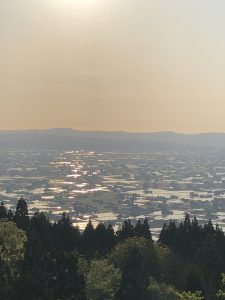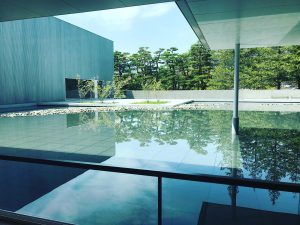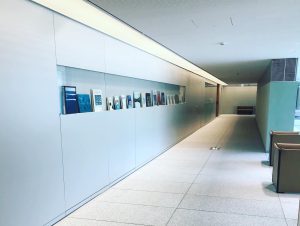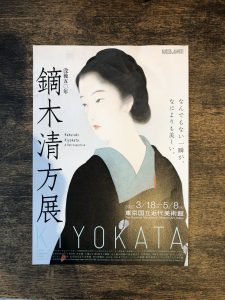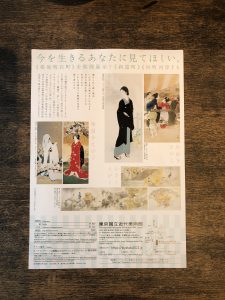1966年「長野県信濃美術館」として開館し、50数年にわたり、長野県民らに愛されてきました。開館以来50数年を経て、全面改築され、2021年4月「長野県立美術館」と名称も新たに生まれ変わりました。新たな本館の建物は、「ランドスケープ・ミュージアム」のコンセプトのもと、城山公園周辺の美しい景色と調和しつつ、その屋上からは国宝善光寺本堂を望む、みごとな眺めをお楽しみいただけます。
東山魁夷館は、日本画家・東山魁夷(1908-1999)から作品と関係図書の寄贈を受け、長野県信濃美術館の併設館として、平成2(1990)年4月に開館 しました。その970余点に及ぶコレクションは、《緑響く》《白馬の森》《夕静寂》などの本制作36点のほか、初期の「ヨーロッパ風景」「旅の写生」「中国風景」、連作「北欧風景」「京洛四季」「白い馬の見える風景」「大和春秋」の習作・スケッチ、日展のための準備作、唐招提寺御影堂障壁画の試作など、画家の自然への感興と制作の全体像を一望できる作品群を収蔵しています。
東山 魁夷(ひがしやま かいい)は、日本の画家、版画家、著述家。昭和を代表する日本画家の一人で、風景画の分野では国民的画家といわれております。文化勲章受章者、千葉県市川市名誉市民で、本名は東山 新吉(ひがしやま しんきち)でございます。
船具商を営んでいた父・浩介と妻・くにの次男として神奈川県横浜市の海岸通に生まれます。父の仕事の関係で3歳の時に兵庫県神戸市西出町へ転居し、兵庫県立第二神戸中学校(現:兵庫高校)在学中から画家を志し、東京美術学校(現:東京芸術大学)日本画科へ進学しました。結城素明に師事したそうです。
在学中の1929年第10回帝展に『山国の秋』を初出品し、初入選を果たし、1931年に美術学校を卒業した後、1933年、ドイツのベルリン大学(現:フンボルト大学)に留学致しました。1934年日本とドイツとの間で交換留学制度が始まり、第1回日独交換留学生(日本からのドイツ学術交流会最初の留学生)として2年間の留学費用をドイツ政府から支給されることになり、11月ベルリン大学文学部美術史科に入学しましたが、父危篤の報を受け奨学金支給期間を1年残したまま日本に帰国致しました。
1940年には日本画家の川﨑小虎の娘すみと結婚致しました。同年、東北地方へのスケッチ旅行で足を延ばした種差海岸(青森県八戸市東部)の風景とそこにいる馬に取材した『凪』を紀元二千六百年奉祝美術展に出展。種差を題材にしたと思われる作品は生涯で17点ほどあり、馬も東山作品のモチーフとなりました。
太平洋戦争に前後して、画業でも家庭でも苦難が続き、1941年には母が脳出血で倒れて療養生活に入り(1945年11月死去)、事業に失敗した父は翌1942年に急死致しました。
1945年4月には母と妻を伴って高山(岐阜県)へ疎開するも、7月には召集令状を受けて入営。熊本県で爆弾を抱えての対戦車体当たり攻撃の訓練を受けるうち終戦を迎えました。召集解除後は小虎、母、妻が疎開していた山梨県中巨摩郡落合村(現:南アルプス市)に一旦落ち着きます。
1945年11月に母が死去すると千葉県市川市に移り、市川では、馬主として知られる同地の実業家である中村勝五郎から住居の提供など支援を受けていました。1946年の第1回日展には落選し、直後に結核療養中だった弟が死去します。東山魁夷は当時の境遇を「どん底」と回想しつつ、「これ以上落ちようがない」と思うとかえって気持ちが落ち着き、「少しずつでも這い上がって行く」決意を固めたそうです。
1947年の第3回日展で、鹿野山(千葉県君津市)からの眺めを描いた『残照』が特選を得て日本国政府に買い上げられたことから世評が高まり、風景を題材とする決意を固め、独自の表現を追求しました。1950年に発表した『道』は、前方へとまっすぐに伸びる道それだけを描く作品で、単純化を極めた画面構成に新機軸が示されています。制作前には種差を再訪し、中村が紹介したと思われるタイヘイ牧場に投宿して写生しました。
北欧、ドイツ、オーストリア、中国と海外にも取材し、次々と精力的に発表された作品は、平明ながら深い精神性を備え、幅広い支持を集めました。同年に日展審査員となり、以後、歴任しました。1956年、『光昏』で日本芸術院賞、1960年に東宮御所(『日月四季図』)、1968年に落成した皇居宮殿の障壁画を担当しました。1961年、吹上御所御用命画『万緑新』。1962年、イタリアのローマ日本文化館に『緑岡』。1965年、日本芸術院会員、日展に『白夜光』。1968年、皇居新宮殿壁画『朝明けの潮』、文化財保護審議会専門委員。1969年、毎日芸術大賞、文化勲章、文化功労者。1970年、東京国立博物館評議員。1973年、自然環境保全審議会委員。1974年、日展理事長に就き、翌1975年に辞任しました。1970年代には約10年の歳月をかけて制作した奈良・唐招提寺御影堂障壁画『黄山暁雲』は畢生の大作となりました。
千変万化する山の姿を墨の濃淡を使い分け、鮮やかに描き出しました。東山は黄山を「充実した無の世界」と表現しました。混沌とした自然の移ろいにあらゆるものを生み出すエネルギーを感じ取りました。この計画を手がけたことにより国内での知名度と人気はさらに高まり、国民的日本画家とも呼ばれるようになります。画集のみならず文章家でもあり画文集など、著作は数多く、川端康成とも親交が深かったそうです。
ドイツ留学中に知ったドイツロマン主義の画家、カスパー・ダーヴィト・フリードリヒを日本に初めて紹介したのも彼だそうです。また、瀬戸大橋のライトグレー色を提案したことでも知られております。
1975年、フランスのパリ吉井画廊で唐招提寺障壁画習作展、ドイツのケルン日本文化会館で同習作展。1976年、パリ吉井画廊で京洛四季習作展。1977年、パリ唐招提寺展に障壁画を出陳致しました。1978年、中華人民共和国の北京と瀋陽で東山魁夷展、パリで『コンコルド広場の椅子』原画展。1979年、ドイツのベルリンとライプチヒで東山魁夷展。1980年、第二期唐招提寺障壁画制作。1981年、唐招提寺鑑真和上像厨子絵『瑞光』を制作・奉納。東京国立近代美術館で東山魁夷展。1982年、国立国際美術館で東山魁夷展。1983年、ドイツのミュンヘン、デュッセルドルフ、ブレーメンで東山魁夷展。1984年、西ドイツ最高栄誉であるプールルメリット学術芸術院会員に選ばれ、ボンで会員章を大統領臨席の下で授与しました。1986年、日中文化交流協会代表団団長として訪中。1988年、京都市美術館、名古屋市美術館、兵庫県立美術館で東山魁夷展。1990年、東京の日本橋髙島屋でベルリンハンブルクウィーン巡回展帰国記念東山魁夷展。1995年、東京、京都、長野で米寿記念東山魁夷展。1996年、長野県内の高等学校106校に東山魁夷画集図録を贈呈。1997年、神戸、福岡で、米寿を迎えて-東山魁夷「私の森」展。
1999年、老衰のため90歳で死去、従三位、勲一等瑞宝章。生前、日展への出品作など代表作の多くを東京国立近代美術館と長野県に寄贈致しました。その他、少年時代を過ごした神戸市にある兵庫県立美術館、祖父の出身地である香川県坂出市の「香川県立東山魁夷せとうち美術館」にも、版画を中心とする作品が寄贈されています。戦後の復員直後から死去するまで暮らしていた千葉県市川市には、自宅に隣接して「市川市東山魁夷記念館」が開館しました。また、美術学校時代のキャンプ旅行の途中、激しい夕立に遇った際に温かいもてなしを受けたことに感謝して後に寄贈された約500点の版画を収蔵する「東山魁夷 心の旅路館」が、岐阜県中津川市(旧長野県木曽郡山口村)にあるそうです。
2000年、福岡、東京、名古屋でパリ展帰国記念東山魁夷展。信濃美術館で東山魁夷館10周年記念展東山魁夷の世界。2004年、横浜美術館で東山魁夷展ひとすじの道。2005年、坂出市沙弥島で香川県立東山魁夷せとうち美術館開館記念展。市川市で市川市東山魁夷記念館開館記念特別展。2008年、東京、長野で生誕100年東山魁夷展。2018年、東京、京都で生誕110年東山魁夷展が開催されました。
Hello everyone
This is Staff N.
The other day, I went to the Nagano Prefectural Art Museum to see the works of my acquaintances.
This building has just received the “AIJ Prize” (work category) on April 19, 2022.
Opened as “Nagano Prefectural Shinano Museum” in 1966, it has been loved by the people of Nagano for more than 50 years. Over 50 years after its opening, it was completely renovated and reborn in April 2021 as the “Nagano Prefectural Art Museum”. Under the concept of “Landscape Museum”, the new main building is in harmony with the beautiful scenery around Shiroyama Park, and you can enjoy a magnificent view of the national treasure Zenkoji main hall from its rooftop.
In addition to the extensive exhibition space, there are many zones where you can enjoy it for free, and it is a truly “open museum” that is free like a park and can be easily visited by anyone, regardless of age or gender.
It was a wonderful space that made you want to stay all day long, such as a restaurant overlooking Zenkoji Temple, an open cafe overlooking the mountains, and a relaxing water garden.
Since it’s a big deal, I also went to Higashiyama Kaiikan.
Kaii Higashiyama was opened in April 1990 as an annex to the Shinano Museum of Art in Nagano Prefecture, with works and related books donated by the Japanese painter Kaii Higashiyama (1908-1999). The 970-plus collection includes 36 works such as “Green Sound”, “Hakuba no Mori”, and “Yu Silence”, as well as the early “European Landscape”, “Travel Sketch”, “Chinese Landscape”, and the series “Northern Europe”. The painter’s impression of nature and the whole production, such as the study and sketches of “Landscape”, “Kyoraku Shiki”, “Landscape where white horses can be seen”, and “Yamato Haruaki”, the preparatory work for the daily exhibition, and the trial production of the Toshodaiji Mikagedo barrier painting. It has a collection of works with a panoramic view of the statue.
I checked about Kaii Higashiyama here.
Kaii Higashiyama is a Japanese painter, print painter, and writer. He is one of the representative Japanese painters of the Showa era and is said to be a national painter in the field of landscape painting. He is a recipient of the Order of Culture, an honorary citizen of Ichikawa City, Chiba Prefecture, and his real name is Shinkichi Higashiyama.
Born in Kaigandori, Yokohama City, Kanagawa Prefecture, as the second son of his father, Kosuke, and his wife, Kuni, who ran a ship equipment dealer. Due to my father’s work, I moved to Nishidemachi, Kobe City, Hyogo Prefecture when I was 3 years old. I went to the Japanese art department. He studied under Yuuki Somei.
“Autumn of the Mountains” was exhibited for the first time at the 10th Imperial Exhibition in 1929 while attending school, and after graduating from art school in 1931, in 1933, at the University of Berlin (currently Humboldt University) in Germany. I studied abroad. In 1934, the exchange study abroad system started between Japan and Germany, and the German government will pay the study abroad expenses for two years as the first Japanese-German exchange student (the first international student of the German Academic Exchange Association from Japan). In November, I entered the Department of Art History, Faculty of Letters, University of Berlin, but returned to Japan with one year of scholarship payment due to my father’s seriousness.
In 1940 he married the daughter of Japanese painter Kawasaki Shoko. In the same year, he exhibited “Nagi”, which covered the scenery of Tanesashikaigan (eastern Hachinohe City, Aomori Prefecture) and the horses there on a sketch trip to the Tohoku region, at the 2600 AD Celebration Art Exhibition. There are about 17 works that seem to be based on Tanesashi in his life, and horses became the motif of Higashiyama’s works.
Before and after the Pacific War, hardships continued in both painting and home, and in 1941 his mother collapsed due to cerebral hemorrhage and entered a medical treatment life (died in November 1945), and his father who failed in business died suddenly in 1942. I did.
In April 1945, he evacuated to Takayama (Gifu Prefecture) with his mother and wife, but in July he entered the company after receiving a convocation letter. He came to an end while he was trained in Kumamoto prefecture to attack against a car with a bomb. After the convocation was lifted, Kotora, his mother, and his wife settled down in Ochiai Village, Nakakoma District, Yamanashi Prefecture (currently Minami Alps City).
When my mother died in November 1945, I moved to Ichikawa City, Chiba Prefecture, where Ichikawa received support such as housing from Katsugoro Nakamura, a businessman in the same area known as a horse owner. His younger brother, who was undergoing treatment for tuberculosis, died shortly after being rejected for the 1946 Japan Fine Arts Exhibition. Kaii Higashiyama recalled his circumstances at that time as “deep bottom”, but when he thought “I couldn’t fall anymore”, he felt calm and decided to “crawl up little by little”.
At the 3rd Japan Fine Arts Exhibition in 1947, “Afterglow” depicting the view from Mt. Kanou (Kimitsu City, Chiba Prefecture) was selected and purchased by the Government of Japan. I made up my mind and pursued my own expression. “Michi”, released in 1950, is a work that depicts only the road that extends straight forward, and shows a new innovation in the screen composition that is extremely simplified. Before the production, he revisited Tanesashi and stayed at Taihei Bokujo, which Nakamura probably introduced, to make a sketch.
In 1953, he built his home designed by Junzo Yoshimura, a university alumnus, and continued his creative activities there for over 50 years.
He has also interviewed Scandinavia, Germany, Austria, China and abroad, and his works, which have been energetically released one after another, have a clear yet deep spirituality and have gained widespread support. In the same year, he became a judge for Japan Fine Arts Exhibition, and has served since then. In 1956, he was in charge of the Japan Art Academy Prize for “Koukai”, the Tomiya Imperial Residence (“Sun Moon Four Seasons”) in 1960, and the barrier painting of the Imperial Palace, which was completed in 1968. In 1961, he was the Fukiage Omiya palace painting “Manryokushin”. In 1962, “Midorioka” was held at the Japanese Cultural Center in Rome, Italy. In 1965, a member of the Japan Art Academy, “White Night Light” at the Japan Fine Arts Exhibition. In 1968, he was a member of the Cultural Properties Protection Council, a mural painting of the Imperial Palace New Palace “The Tide of the Dawn”. 1969, Mainichi Art Award, Order of Culture, Person of Cultural Merit. 1970, Tokyo National Museum Councilor. In 1973, he was a member of the Natural Environment Conservation Council. In 1974, he became chairman of the Japan Fine Arts Exhibition and resigned in 1975. In the 1970s, the barrier painting “Huangshan Xiaoyun” at Toshodaiji Temple in Nara, which took about 10 years, became his masterpiece.
He vividly portrayed the ever-changing appearance of the mountain by using different shades of ink. Huangshan described Huangshan as a “fulfilling world of nothingness.” He felt the energy to create everything in the chaotic transition of nature. By working on this plan, his name and popularity in Japan became even higher, and he became known as a national Japanese painter. He is not only an art book but also a writer, and he has written many books such as art books, and he has a close relationship with Yasunari Kawabata.
He was the first to introduce Caspar David Friedrich, a German Romantic painter he learned while studying in Germany, to Japan. He is also known for proposing the light gray color of Setoo Bridge.
In 1975, he exhibited the Toshodaiji Barrier Painting Exhibition at the Yoshii Gallery in Paris, France, and the same exhibition at the Japanese Culture Institute in Cologne, Germany. In 1976, the Kyoto Raku Shiki Study Exhibition at the Yoshii Gallery in Paris. In 1977, he exhibited a barrier painting at the Toshodaiji Temple exhibition in Paris. In 1978, Kaii Higashiyama exhibition in Beijing and Shenyang, People’s Republic of China, and “Chairs in Concorde Square” original painting exhibition in Paris. In 1979, Kaii Higashiyama exhibition in Berlin and Leipzig, Germany. In 1980, produced the second Toshodaiji barrier painting. In 1981, he produced and dedicated the painting “Ruikou” by Toshodaiji Jianzhen. Kaii Higashiyama exhibition at the National Museum of Modern Art, Tokyo. In 1982, Kaii Higashiyama exhibition at the National Museum of Art, Osaka. In 1983, Kaii Higashiyama exhibition in Munich, Dusseldorf, Bremen, Germany. In 1984, he was elected a member of the Pour le Mérite Academy of Arts and Sciences, the highest honor in West Germany, and was awarded the membership badge in Bonn in the presence of the President. In 1986, he visited China as the delegation leader of the Japan-China Cultural Exchange Association. In 1988, Kaii Higashiyama exhibition at Kyoto City Museum of Art, Nagoya City Museum of Art, and Hyogo Prefectural Museum of Art. In 1990, at the Nihonbashi Takashimaya in Tokyo, the Berlin-Hamburg Vienna Tour Exhibition Commemorating the Return to Japan, Kaii Higashiyama Exhibition. In 1995, Kaii Higashiyama exhibition to commemorate the US life in Tokyo, Kyoto and Nagano. In 1996, presented a catalog of Kaii Higashiyama art books to 106 high schools in Nagano prefecture. In 1997, in Kobe and Fukuoka, celebrating Yoneju-Kaii Higashiyama “My Forest” exhibition.
In 1999, he died at the age of 90 due to senility. During his lifetime, he donated many of his masterpieces, including works exhibited at the Japan Fine Arts Exhibition, to the National Museum of Modern Art, Tokyo and Nagano Prefecture. Other works centered on his prints are also in the Hyogo Prefectural Museum of Art in Kobe, where he spent his childhood, and the “Kagawa Prefectural Higashiyama Kaiso Setouchi Museum” in Sakaide City, Kagawa Prefecture, where his grandfather was born. Has been donated. In Ichikawa City, Chiba Prefecture, where he lived from immediately after his demobilization after the war until his death, the “Ichikawa City Higashiyama Kaii Memorial Hall” was opened next to his home. Also, during the camping trip during the art school days, the “Higashiyama Kisoshin no Tabikan”, which houses about 500 prints donated later in gratitude for receiving warm hospitality during the intense evening rain. Is located in Nakatsugawa City, Gifu Prefecture (formerly Yamaguchi Village, Kiso District, Nagano Prefecture).
2000, Kaii Higashiyama exhibition commemorating the return to Paris exhibition in Fukuoka, Tokyo and Nagoya. Higashiyama Kaiikan 10th Anniversary Exhibition at Shinano Museum of Art The world of Higashiyama Kaii. In 2004, Kaii Higashiyama Exhibition at the Yokohama Museum of Art. In 2005, an exhibition commemorating the opening of the Kagawa Prefectural Higashiyama Kaiso Setouchi Museum in Shamijima, Sakaide City. A special exhibition commemorating the opening of the Kaii Higashiyama Memorial Hall in Ichikawa City. In 2008, Kaii Higashiyama’s 100th birthday exhibition in Nagano, Tokyo. In 2018, the 110th anniversary of his birth, Kaii Higashiyama Exhibition was held in Tokyo and Kyoto.
I couldn’t take a picture, but N, who likes blue among the colors, was fascinated by the world of Kaii Higashiyama at once.
“Higashiyama Kaisoshin no Tabikan” Nakatsugawa City, Gifu Prefecture is also very worrisome.
I may introduce it in this blog someday.
See you soon



